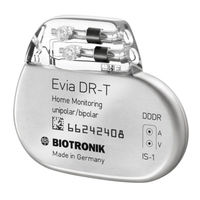User Manuals: BIOTRONIK Evia SR Pulse Generator
Manuals and User Guides for BIOTRONIK Evia SR Pulse Generator. We have 1 BIOTRONIK Evia SR Pulse Generator manual available for free PDF download: Technical Manual
BIOTRONIK Evia SR Technical Manual (183 pages)
Family of Implantable Pulse Generators
Brand: BIOTRONIK
|
Category: Portable Generator
|
Size: 0 MB
Table of Contents
Advertisement
Advertisement
